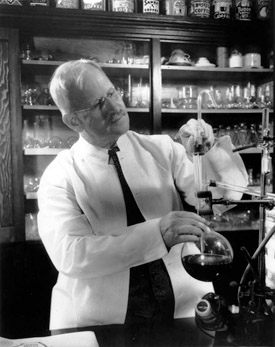Recommended

In our Starbucks-infused world, we like to think the proliferation of coffee and espresso connoisseurs among us defines our times in a novel way, but it seems MIT had already cracked the mystery of the ideal cup of joe long ago. Yesterday, while perusing the MIT150 exhibit at the MIT Museum (highly recommended, by the way), I came across a George Washington coffee can along with this keen bit of trivia: In 1920, the National Coffee Roasters Association gave Professor Samuel Cate Prescott $40K to brew the perfect cup of coffee.
Why? Because coffee consumption, which quadrupled from 1830 to 1900, had fallen off, in part because of growing health concerns. Opponents deemed it "slow poison." Coffee advertisers needed a new angle, so they turned to science. Larry Owens wrote a fascinating piece about the endeavor. The facts I give you here come from his article.
Prescott was a logical choice for the coffee advertisers. In 1914, he helped the United Fruit Company establish the first banana research lab in Costa Rica. Perfecting food was one of his passions.
Prescott's Coffee Research Laboratory force-fed rabbits and determined that humans would need to ingest between 150 and 200 cups in one sitting for it to prove fatal. He also formed a "tasting squad" of secretaries, young instructors, lab workers, and more and over the course of three years served them coffee made using a variety of water, temperatures, and pots. He made coffee that had been boiled, dripped, and filtered. Finally, he perfected the formula, which is, according to the Museum, "one tablespoon of coffee per eight ounces of water, just short of boiling, in glass or ceramic containers, never boiled, reheated, or reused."
Prescott's final report also said, according to Owens, that coffee, "properly prepared and rightly used, gives comfort and inspiration, augments mental and physical activity, and may be regarded as the servant rather than the destroyer of civilization.”
Ads related to Prescott's work appeared in over 1,200 newspapers and magazines with a daily circulation of 36 million. Some of the slogans used: “The Proof at Last!” “The Facts about Coffee,” “Coffee is a Safe and Desirable Beverage,” “Coffee Gives Comfort and Inspiration,” and “Read What This Famous Scientist Says About Coffee.”








Comments
David Sternlight
Wed, 03/09/2011 5:46pm
$400K in 2008 dollars. But now he'd probably have to include a $12,000 Clover machine in his study, and pay a lot more for the beans.
But seriously, folks....I didn't realize that this standard coffee brewing measure today originated from MIT studies in 1920. Good catch by the MIT Museum.